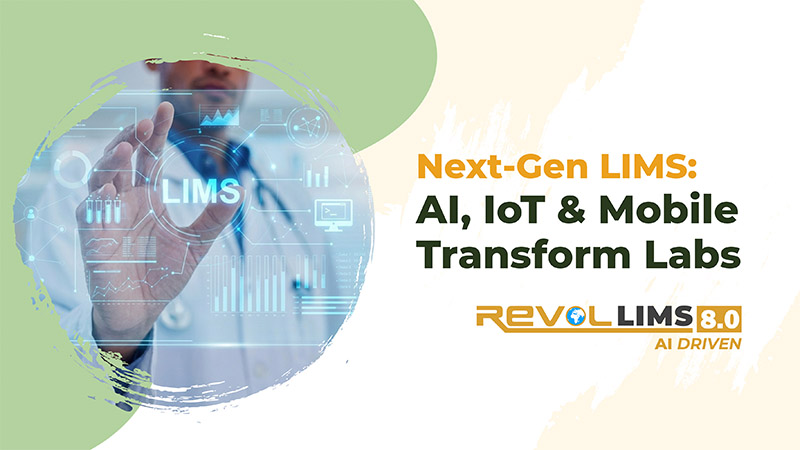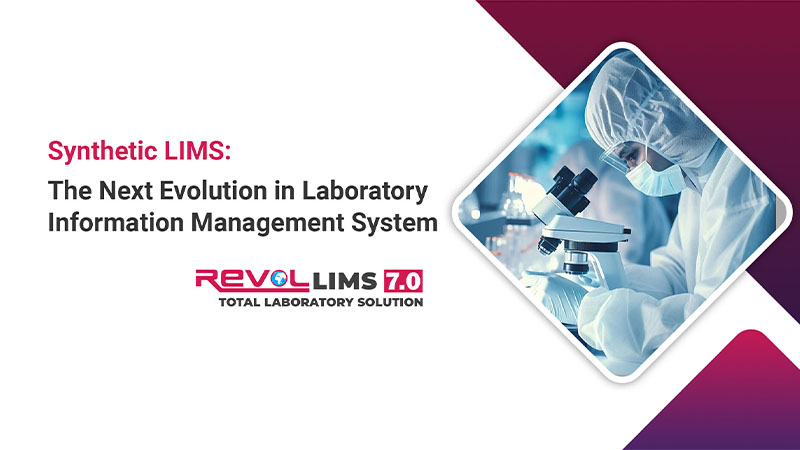
Did you know that in 2022, 35% of businesses adopted AI, marking a 4% increase from 2021? By the end of 2023, this growth rate has become even more pronounced. India’s AI adoption index score for 2024 is 2.47 on a 4-point scale, up from 2.45 in 2022, with 87% of companies falling between the Enthusiast and Expert stages of AI adoption. According to research by Exploding Topics, 77% of companies are either using or considering AI, and 83% consider AI as a top priority in their business strategies.
As organizations evolve with the integration of artificial intelligence and Machine learning (AI/ML) in their day to day operations. It is imperative that quality laboratory operations have to prepare themselves for this paradigm shift. This shift promises to enhance efficiency by providing predictive analytical insights and making decisions based on data.
Understanding AI's Role in Quality Laboratory Data Management AI can remarkably streamline lab data management
 Data Analysis: AI can process vast amounts of data, identifying trends and anomalies that could be cumbersome and result in error prone task.
Data Analysis: AI can process vast amounts of data, identifying trends and anomalies that could be cumbersome and result in error prone task. Automation: Routine tasks, such as data entry and report generation, can be automated, allowing team to focus on core responsibilities.
Automation: Routine tasks, such as data entry and report generation, can be automated, allowing team to focus on core responsibilities.-
 Predictive Analytics: AI can forecast outcomes based on historical data, assisting in proactive decision-making.
Predictive Analytics: AI can forecast outcomes based on historical data, assisting in proactive decision-making.  Quality Assurance: Continuous monitoring and analysis can help maintain data integrity and compliance with regulatory standards.
Quality Assurance: Continuous monitoring and analysis can help maintain data integrity and compliance with regulatory standards.
Assessing Current Infrastructure Before implementing AI, it’s essential to evaluate your existing data handling system.
 Data Quality: AI relies heavily on data quality. Ensure your data is accurate, consistent, and well-organized for effective analysis.
Data Quality: AI relies heavily on data quality. Ensure your data is accurate, consistent, and well-organized for effective analysis. Integration Capabilities: Compatibility is key to seamless implementation. Access how well your current systems can integrate with AI technologies.
Integration Capabilities: Compatibility is key to seamless implementation. Access how well your current systems can integrate with AI technologies.-
 User Training: Identify training needs to bridge any gaps. Evaluate the skill levels of your team in both data management and AI technologies.
User Training: Identify training needs to bridge any gaps. Evaluate the skill levels of your team in both data management and AI technologies.
Identifying Use Cases
Determine specific areas within your quality laboratory operations where AI could prove boon.
 Sample Workflow Management: Ensuring the complete sample workflow becomes more efficient in terms of tracking, assignment of analysts, inventory and equipment involved in handling the same effectively. Efficient handling of sample storage and discarding processes.
Sample Workflow Management: Ensuring the complete sample workflow becomes more efficient in terms of tracking, assignment of analysts, inventory and equipment involved in handling the same effectively. Efficient handling of sample storage and discarding processes.-
 Predictive Inventory Management (Procurement): Effectively schedule inventory requests to ensure enough sourcing time and ensure timely receipt of stocks.
Predictive Inventory Management (Procurement): Effectively schedule inventory requests to ensure enough sourcing time and ensure timely receipt of stocks.  Predictive Maintenance: AI can help to monitor equipment health, predicting failures before they happen.
Predictive Maintenance: AI can help to monitor equipment health, predicting failures before they happen.
Training data sets based on which AI tools will be trained to make efficient recommendations
Training datasets for AI tools focused on making efficient recommendations typically include various types of data. Here are some types of datasets commonly used:
 User Interaction Data: Records of user behaviour, such as clicks, views, purchases, and time spent on content. This helps in understanding user preferences.
User Interaction Data: Records of user behaviour, such as clicks, views, purchases, and time spent on content. This helps in understanding user preferences.-
 User Interaction Data: Records of user behaviour, such as clicks, views, purchases, and time spent on content. This helps in understanding user preferences.
User Interaction Data: Records of user behaviour, such as clicks, views, purchases, and time spent on content. This helps in understanding user preferences.  Demographic Data: Information about users such as age, gender, location, and interests, which can help tailor recommendations to specific segments.
Demographic Data: Information about users such as age, gender, location, and interests, which can help tailor recommendations to specific segments.-
 Item Attributes: Data about the items being recommended, including descriptions, categories, ratings, and features. This contextual information is crucial for making relevant suggestions.
Item Attributes: Data about the items being recommended, including descriptions, categories, ratings, and features. This contextual information is crucial for making relevant suggestions.  Feedback Data: Ratings, reviews, and explicit feedback from users about items. This helps models learn what users like or dislike.
Feedback Data: Ratings, reviews, and explicit feedback from users about items. This helps models learn what users like or dislike.-
 Temporal Data: Time-based data that tracks when interactions occur, which can be useful for recognizing trends or seasonal preferences.
Temporal Data: Time-based data that tracks when interactions occur, which can be useful for recognizing trends or seasonal preferences. -
 Social Data: Information from social media or networks, such as user connections and shared preferences, which can enhance recommendations through social influence.
Social Data: Information from social media or networks, such as user connections and shared preferences, which can enhance recommendations through social influence. -
 Contextual Data: Data that captures the context of interactions, such as device type, location at the time of interaction, and current trends or events.
Contextual Data: Data that captures the context of interactions, such as device type, location at the time of interaction, and current trends or events. -
 A/B Testing Results: Results from experiments comparing different recommendation strategies, which can provide insights into what works best for different user groups.
A/B Testing Results: Results from experiments comparing different recommendation strategies, which can provide insights into what works best for different user groups.
Choosing the Right AI Tools
Selecting the right AI tools and platforms are crucial. Consider:
 Scalability: Choose solutions that can grow with your lab’s needs.
Scalability: Choose solutions that can grow with your lab’s needs.-
 Usability: Ensure that the tool used is accessible.
Usability: Ensure that the tool used is accessible.  Vendor Support: In order to help your team, adapt to new technologies, opt for vendors that offer robust support and training.
Vendor Support: In order to help your team, adapt to new technologies, opt for vendors that offer robust support and training.
Implementing a Change in management strategy
Introducing AI into data management will require a cultural shift within the organization. A change management strategy should include:
 Communication: Clearly communicate the benefits of AI to all stakeholders to foster buy-in and reduce resistance.
Communication: Clearly communicate the benefits of AI to all stakeholders to foster buy-in and reduce resistance. Training Programs: Develop comprehensive training to ensure that staff are comfortable with new technologies and processes.
Training Programs: Develop comprehensive training to ensure that staff are comfortable with new technologies and processes. Feedback Mechanisms: Establish channels for feedback during the transition, allowing for continuous improvement and addressing concerns promptly.
Feedback Mechanisms: Establish channels for feedback during the transition, allowing for continuous improvement and addressing concerns promptly.
Ensuring Compliance and Security
As data management evolves, so do regulatory requirements. It’s essential to:
 Stay Informed: Keep up-to-date with regulations relevant to lab data management and AI usage.
Stay Informed: Keep up-to-date with regulations relevant to lab data management and AI usage.-
 Data Security: Implement robust security measures to protect sensitive data from breaches and ensure compliance with data protection regulations.
Data Security: Implement robust security measures to protect sensitive data from breaches and ensure compliance with data protection regulations.
Evaluating and Iterating
After implementing AI solutions, continuously evaluate their performance. Metrics to consider include:
-
 Efficiency Gains: Measure time savings in data management and reporting.
Efficiency Gains: Measure time savings in data management and reporting. -
 Data Accuracy: Assess improvements in data integrity and error rates.
Data Accuracy: Assess improvements in data integrity and error rates. -
 User Satisfaction: Gather feedback from staff to identify areas for further enhancement.
User Satisfaction: Gather feedback from staff to identify areas for further enhancement.



















